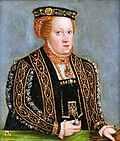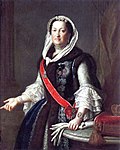Grand Duchess of Lithuania
Mindaugas Dynasty
| Picture | Name | Father | Birth | Marriage | Became Grand Duchess | Ceased to be Grand Duchess | Death | Spouse |
|---|---|---|---|---|---|---|---|---|
| - | Morta | - | - | around 1219 | 1235 husband's accession | 1263 | Mindaugas | |
| - | Sister of Morta | - | - | after 1263 | 12 September 1263 husband's death | - | ||
| - | Ramunė [1] [2] | Mindaugas (Mindaugas) | - | 1254/5 | 1267 husband's accession | 1269 husband's death | - | Shvarn |
| - | Ludmila of Masovia? | Konrad I of Masovia (Piast) | 1223 | 1238 | 1270 husband's accession | 1282 husband's death | - | Traidenis |
Gediminid Dynasty
| Picture | Name | Father | Birth | Marriage | Became Grand Duchess | Ceased to be Grand Duchess | Death | Spouse |
|---|---|---|---|---|---|---|---|---|
| Vida | Vidmund | It is uncertain how many wives Gediminas had. The Bychowiec Chronicle mentions three wives: Vida from Courland; Olga from Smolensk; and Jaunė from Polotsk, who was Eastern Orthodox and died in 1344 or 1345. [3] Most modern historians and reference works say Gediminas' wife was Jaunė, dismissing Vida and Olga as fictitious, since no sources other than this chronicle mention the other two wives. [4] | Gediminas | |||||
| Olga Vsevolodovna of Smolensk | Vsevolod of Smolensk (Rurikids?) | |||||||
| Jaunė (Ievna Ivanovna of Polotsk) | Ivan Vsevolodich, Prince of Polotsk (Rurikids?) | ? | - | Winter of 1341 husband's death | 1344/5 | |||
| Maria Yaroslavna of Vitebsk | Yaroslav Vasilievich, Prince of Vitebsk (Rurikids?) | ? | 1318 | 1345 husband's accession | before 1349 | Algirdas | ||
| Uliana Alexandrovna of Tver | Aleksandr Mikhailovich of Tver (Rurikids) | 1325 | 1350 | May 1377 husband's death | Autumn of 1392 | |||
| Birutė | - | - | before 1349 | 3/15 August 1382 husband's death | Fall 1382 | Kęstutis | ||
 | Jadwiga of Poland | Louis I of Hungary (Anjou-Hungary) | between 3 October 1373 and 18 February 1374 | 18 February 1386 | 17 July 1399 | Jogaila | ||
| Anna of Cilli | William, Count of Celje | 1381 | 29 January 1402 | 21 May 1416 | Jogaila | |||
| Elizabeth of Pilica | Otto of Pilica | 1370/1380 | 2 may 1417 | 12 May 1420 | Jogaila | |||
| Sophia of Halshany | Andrew of Halshany | 1405 | 24 or 7 February 1422 | 1 June 1434 husband's death | 21 September 1461 | Jogaila | ||
| Anna | probably a Lithuanian noble or a Rurikid | ? | around 1370 | 4 August 1392 husband's accession | 31 July 1418 | Vytautas | ||
| Uliana Olshansky | Ivan Olshansky (Olshanski) | ? | 9 November 1418 | 27 October 1430 husband's death | 1448? | |||
| Anna of Tver | Ivan Ivanovich of Tver Rurikid | ? | 1430? | 1430? | 1 September 1432 power passed to Sigismund Kęstutaitis | Between 1471 and 1484 [5] | Švitrigaila | |
| Unknown | Unknown | - | January 1416 | 1 September 1432 husband's accession | Middle 1434 | Sigismund Kęstutaitis | ||
 | Elisabeth of Austria [6] | Albert II of Germany (Habsburg) | 1435/36/possibly 1437 | 10 March 1454 | 7 June 1492 husband's death | 30 August 1505 | Casimir I | |
 | Helena of Moscow [6] | Ivan III of Russia (Rurikids) | 19 May 1476 | 18 February 1495 | 19 August 1506 husband's death | 20 January 1513 | Alexander | |
 | Barbara Zápolya [6] | Stephen Zápolya (Zápolya) | 1495 | 8 February 1512 | 2 October 1515 | Sigismund I | ||
 | Bona Sforza [6] | Gian Galeazzo Sforza (Sforza) | 13 February 1495 | 18 April 1518 in Wawel Cathedral | 1 April 1548 husband's death | 7 November 1558 | ||
 | Elisabeth of Austria [6] | Ferdinand I, Holy Roman Emperor (Habsburg) | 9 July 1526 | 5 May 1543 | 15 June 1545 | Sigismund II Augustus | ||
 | Barbara Radziwiłł [6] | Jerzy Radziwiłł (Radziwiłł) | 6 December 1520 or 1523 | July/August 1547 | 17 April 1548 | 8 May 1551 | ||
 | Catherine of Austria [6] | Ferdinand I, Holy Roman Emperor (Habsburg) | 15 September 1533 | 23 June 1553 | 28 February 1572 | |||








